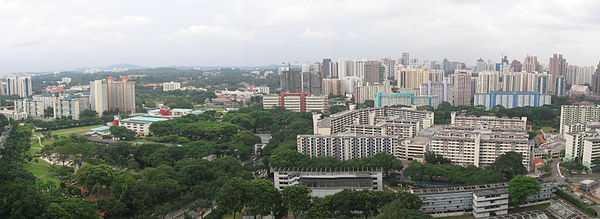Bukit Ho Swee Fire
The Bukit Ho Swee Fire (Chinese: 河水山大火) is a fire that broke out in the squatter settlement of Bukit Ho Swee, Singapore, on May 25, 1961 at 3.20 p.m. Four people died, eighty-five were injured,16,000 were made homeless and more than 2,200 attap houses were destroyed.[1] Despite the low casualty numbers, the scale of the destruction and property damages worth $2 million[2] would set a historical precedent and the fire is considered a pivotal point in the physical modernization of Singapore.[3]
Prior to the fire, the Bukit Ho Swee kampong was one of the largest surviving kampongs. The Housing and Development Board had been slowly replacing kampongs with modern flats for safety and hygiene reasons but the residents of Bukit Ho Swee resisted. Gangsterism was rife and basic commodities such as clean running water and proper sewer systems were nearly nonexistent.
Timeline
At 3:30pm, a fire started in Kampong Tiong Bahru. Multiple factors such as wind direction, flammable construction materials used by kampong residents to construct their attap houses and the presence of oil and petrol in homes caused it to quickly spread across the road to the kampongs along Beo Lane and in Bukit Ho Swee up until Havelock Road. It reached the HDB flats in Delta Estate (Ganges Avenue) and was visible from the flats, causing some worried residents to flee for their safety. Bukit Ho Swee was completely overwhelmed by the now raging inferno. As it was the Hari Raya Haji public holiday and many firefighters were Malay Muslims, many of the predominantly Malay firefighter force had to be recalled to their duties. The fledgling local military forces and British Army personnel still stationed on the island were also called in to assist the police with maintaining order.
By 5pm, the thousands of residents were housed in several school buildings at Kim Seng Road. Firefighters were still having difficulty containing the fire. Further complicating their mission was the fact that processing plants and mills in Bukit Ho Swee had also caught on fire and exploded, causing toxic chemicals to be released into the air.
The conflagration peaked around 8pm. Even after the flames were extinguished, the debris continued smouldering for much of the night. The wide Ganges Avenue served as a firebreak and deterred the flames from advancing further to the flats at Delta Estate. By the time the fire was extinguished, a maximum of twenty two fire engines had been deployed.[4]
Aftermath
In the days following the fire, there was a massive charity drive to aid the victims of the fire, methods of which included selling admission to several theatre performances and an ice cream social.
The government acquired the land and began reconstruction immediately after the fire to house the homeless. The Housing Development Board (HDB), chaired by Lim Kim San, quickly resettled the victims of the fire to recently built flats in the Queenstown and St. Michael areas. The government then built the first five blocks of 768 flats in just 9 months. During the next four years, over 8,000 flats were built and those who lost their homes were able to return.
Cause
The cause of the fire is thought to be the immense flammability of the squatter settlement, in addition to the cramped space. Whether the fire was due to arson or accident remains a mystery today. According to the Days of Disaster documentary series broadcast by Channel NewsAsia, other causes that have been speculated include a gangster fight gone wrong and fire from a cooking stove. Nevertheless, the aftermath of the fire promoted a shift of people into the HDB-built public housing.
Subsequent fire
A squatter settlement, albeit smaller than the original kampong, soon re-emerged, despite the construction of emergency flats. On 24 November 1968 the new settlement caught fire again, rendering 3,000 people homeless. [5] Following the fire, there was again another set of charity-based relief efforts.

References
- ↑ "Milestone - 1888-1990". Singapore Civil Defence Force. Retrieved 2006-07-17.
- ↑ Loh, K. S., p.148
- ↑ Loh, K. S., p.2-3
- ↑ "Bukit Ho Swee Fire". Singapore Infopedia. National Library Board.
- ↑ "Our History". Beyond Social Services. Retrieved 2006-07-19.
- "Bukit Ho Swee Fire". Days of Disaster. 8 February 2015. Channel NewsAsia.
- Loh, Kah Seng. Squatters into Citizens: The 1961 Bukit Ho Swee Fire and the Making of Modern Singapore. NUS Press.